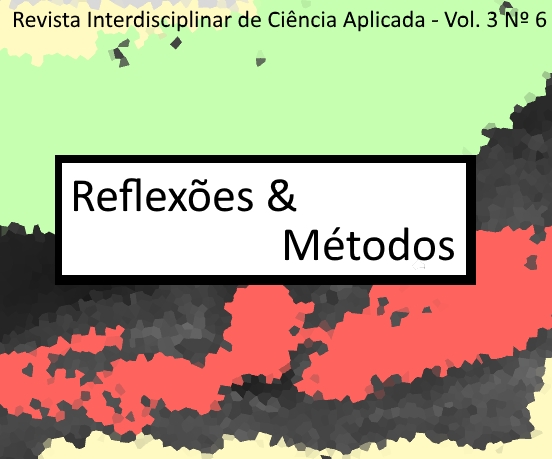Chemical route for the production of graphene oxide from commercial graphite oxidation
Keywords:
graphene oxide, FTIR, TGA, FEG-SEMAbstract
This work presents the synthesis of graphene oxide (GO) by a chemical route. Commercial graphite was used as raw material and the method used to obtain GO was Hummers and Hoffman method. GO was characterized by means of Fourier Transform Infrared Spectroscopy (FTIR), thermogravimetry (TGA) and field emission scanning electron microscopy (FEG-SEM). The FTIR results confirm the presence of carbonyl, hydroxyl and epoxy groups and the TGA demonstrates that GO presents three mass loss events, while graphite has only one mass loss event. The graphite morphology shows the formation of aggregates in the sample surface, while GO presents formation of layers. Finally, the characterizations demonstrated the production of graphene oxide from commercial graphite using the chemical method proposed.
References
OLIVEIRA, M.M.; ZARDIN, G.J.A.; “Nanoestrutura de Carbono (Nanotubos, Grafeno): Quo Vadis?” Química Nova, v.36, p. 1533-1539, 2013.
BIELAWSKI, W. C.; DREYER, R.D.; PARK, S.; RUOFF, S.R.; “The chemistry of graphene oxide.” Chemical Society Reviews, v.39, p. 228-240, 2010.
PEI, S.; CHENG, H-M. “The reduction of graphene oxide”. Carbon, v. 50, 2012, pg. 3210-3228.
ZHONG, Y.; ZHEN, Z.; ZHU, H. “Graphene: fundamentals research and potential applications”. FlatChem, v. 4, 2017, pg.20-32.
KHAN, Z.U.; KAUSAR, A.; ULLAH, H.; BADSHAH, A.; KHAN, W.U. “A review of graphene oxide, graphene buckypaper, and polymer/graphene composites: properties and fabrication techniques”. Journal of Plastic Film and Sheeting. v. 32, 2016, pg. 336-379.
FREIRE, E.; GUIMARÃES, C.O.J.M.; JESUS, D.A.K.; “Grafeno: Aplicação e Tendências Tecnológicas.” Revista de Química Industrial. v.737, 2012, pg. 14-19.
DOMINGUES, H.S.; MATOS, F,C.; MEHL, H.; NEIVA, C.G. E.; ZARBIN, G. J. A.; “Efeito da variação de parâmetros reacionais na preparação de grafeno via oxidação e redução do grafite.” Química Nova, v.37, p. 1639-1645, 2014.
MOO, James Guo Sheng et al. “Graphene Oxides Prepared by Hummers’, Hofmann’s, and Staudenmaier’s Methods: Dramatic Influences on Heavy-Metal-Ion Adsorption.” Chemphyschem, [s.l.], v. 15, n. 14, p.2922-2929, 17 jul. 2014. Wiley.
LÓPEZ, Mara del Prado Lavín et al. “Optimization of the Synthesis Procedures of Graphene and Graphite Oxide.” Recent Advances in Graphene Research, [s.l.], p.113-133, 12 out. 2016.
GONZALES, M.; “A chatice do grafeno e seus superpoderes.” Disponível em: <http://www.notasgeo.com.br/2017/12/a-chaticedo-grafenoe-seus-superpoderes.html>. Acesso em 12 de agosto de 2018.
ALENCAR, E.; SANTANA, D; “Processo de obtenção do grafeno, suas aplicações e sua importância para o Brasil.” Revista Acadêmica Oswaldo Cruz (revista on-line), ed. 16, 2017.
BALZARETTI, Naira Maria et al. “Few Layer Reduced Graphene Oxide: Evaluation of the Best Experimental Conditions for Easy Production.” Material Research, p. 53-61, 2017.
BLASKIEVICZL, F.S.; DOMINGUES, H.S.; FONSACAL, S.E.J.; ORTHL, S.E.; ZARDINL, A.; “Funcionalização de óxido de grafeno com derivado de imidazol: projeção de nanocatalisadores.” 37° Reunião Anual da Sociedade Brasileira de Química, Natal, 2014.
CHEN, J.; YAO. B.; LI, C.; SHI, G. “Na improved Hummers method for eco-friendly synthesis of graphene oxide.” Carbon, v. 64, 2013, pg. 225-229.
PAVOSKI, G.; MARASCHIN, T.; FIM, F.C.; BALZARETTI, N.M.; GALLAND, G.B.; MOURA, C.S.; BASSO, N.R.S. “Few layer reduced graphene oxide: evaluation of the best experimental conditions for easy production.” Materials Research, v. 20, 2017, pg. 53-61.
ALAM, N.S.; KUMAR, L.; SHARMA, N.; “Synthesis of Graphene Oxide (GO) by Modified Hummers Method and Its Thermal Reduction to Obtain Reduced Graphene Oxide (rGO)”. Scientific Research Publishing, v.6, p. 1-18, 2017.
CESAR, V. D.; COSTA, B.C.; SENNA, F.L.; da SILVA, P.D.; “Síntese e caracterização do óxido de grafite como precursor de folhas de grafeno.” XX Congresso Brasileiro de Engenharia Química, Florianópolis, 2014.
DEDAVID, AN.B.; GOMES, I.C.; MACHADO, G.; “Microscopia Eletrônica de Varredura: Aplicações e preparação de amostras: Materiais poliméricos, metálicos e semicondutores.” [recurso eletrônico] – Porto Alegre: EDIPUCRS, 2007.
KHATAEE, A.; SAFARPOUR, M.; VATANPOUR, V.; “Thin film nanocomposite reverse osmosis membrane modified by reduced graphene oxide/TiO2 with improved desalination performance.” Journal of Membrane Science (revista on-line), ed. 489, 2015, p. 43-54.
HAO, Q.; LU, L.; WANG, H.; WANG, X.; YANG X.; “Effect of graphene oxide on the properties of its composite with polyaniline.” ACS Applied Materials & Interfaces, v.2. ed. 3, p. 821- 828, 2010.
FARIA, Géssica Seara et al. “Produção e caracterização de óxido de grafeno e óxido de grafeno reduzido com diferentes tempos de oxidação.” Matéria (Rio de Janeiro), [s.l.], v. 22, n. 1, p.1-9, 8 jan. 2018. FapUNIFESP (SciELO).
Downloads
Published
How to Cite
Issue
Section
License
Copyright (c) 2021 Interdisciplinary Journal of Applied Science

This work is licensed under a Creative Commons Attribution-NonCommercial-NoDerivatives 4.0 International License.
Authors keep the copyright and cede to the journal the right of publishing first. Published works are licensed under a Creative Commons Attribution 4.0 International (CC BY 4.0) license, allowing the sharing of the work with recognition of the authorship and initial publication in this journal.






